Ideas
Why D N Jha’s Claim That Ancient Hindus Were Given To Violence Is Far From The Truth
Aravindan Neelakandan
Jun 06, 2018, 04:04 PM | Updated 04:04 PM IST
Save & read from anywhere!
Bookmark stories for easy access on any device or the Swarajya app.
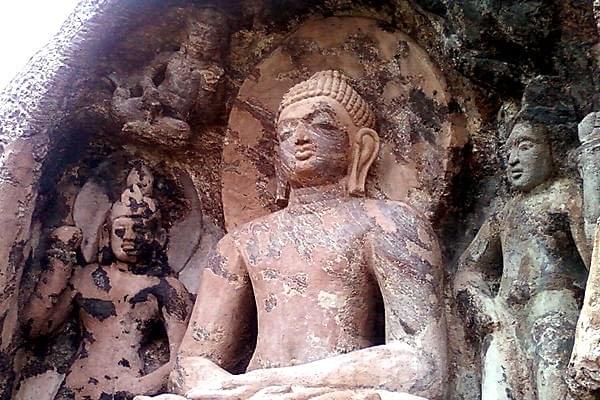
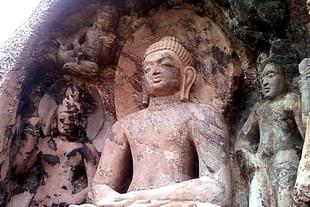
Dwijendra Narayan Jha is a historian belonging to the Soviet-subsidised school of Marxist history in Delhi. Earlier, his books were brought out by People's Publishing House, again, subsidised by the Soviets, and even part of the KGB operations in India.
After the collapse of the Union of Soviet Socialist Republics (USSR), Soviet-sponsored Leftist historians in India, with their contempt for anything Indic, moved to greener pastures of the Western India-phobic market. Jha took that course.
Book-Burning Deception
In the process, Jha promoted his books in curious ways that were more a thud than a sensation, even by Leftist standards. For example, in 2002, when the Atal Behari Vajpayee government was in power, he published The Myth of the Holy Cow. The book came with the tagline: “a book the Government of India demands be ritually burned”. It was for the edition published for a Western audience, through the England-based left publisher Verso. In reality, his book was challenged not with bans but invitations to debate and dialogue. But he shied away from it.
Conjuring a government demand for burning one’s book is definitely a cheaper and more sensational way to sell a book than running the risk of engaging in debates and dialogues with scholars of differing points of view.
So, when Jha came up with another book in 2018, strategically titled Against the Grain: Notes on Identity, Intolerance and History, one expected yet another deceitful attack on Indian culture. And Jha is not one to disappoint; he indulges in deception and then some.
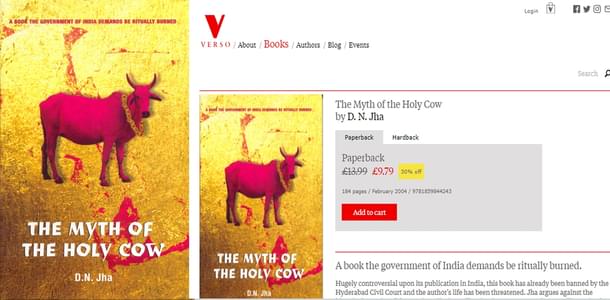
In an uncritical review of the book published on a Left-leaning portal, the reviewer provides a succinct and accurate portrayal of Jha’s attack on ancient Indian culture – as his questioning of the “oft-intoned self-adulatory declarations about India’s rich culture of non-violence religious harmony and tolerance of all communities”.
Here is the “counter evidence” provided by Jha “to interrogate such an idea of India – India as a land of intrinsic religious tolerance”:
Jha disagrees with such a flattering image of ancient India and argues that even if it were to be accepted that Brahmanism gave space to other sects, there still exists enough counter evidence to interrogate such an idea of India – India as a land of intrinsic religious tolerance. “Not only did the different Brahmanical sects fight among themselves, of which we have plenty of evidence, they also bore huge animosity towards the two heterodox religions, Buddhism and Jainism, in early India,” writes Jha. ... Jha observes that the “invectives” against Buddhists and Jains were often channelled through violent and aggressive actions. For instance, the writer cites Hsuan Tsang (seventh century) who wrote about the Huna ruler Mihirakula, a devotee of Shiva, destroying 1,600 Buddhist stupas and monasteries, besides killing thousands of monks and laity. “Although there is evidence that the adherents of Shramainc retaliated against Brahmanism, it remains certain that the Brahmanical sects did not, as they are said to have done, practice tolerance towards non-Brahmanical faiths,” he argues, going on to add: “on the contrary, they seemed to have played a leading role in fomenting religious conflicts and perpetrating sectarian violence during the early medieval period and later.” No wonder, Alberuni (the 11th century Persian scholar who studied India) wrote, according to Jha that, Hindus are “haughty, foolishly vain and self-conceited”. They “believe that there is no religion like theirs”.Monobina Gupta, ‘Textual Evidence from Early India Tells Us the Ancients Weren’t as Tolerant as We Think’
Mihirakula Deception
Let us first take the example of Mihirakula.
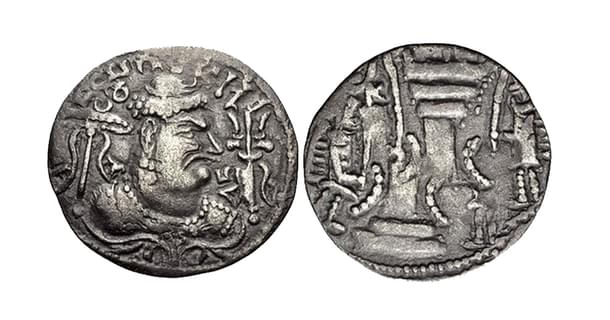
This is what we know about him. He was a Hun emperor, who ruled the Hephthalite Empire in the north-western part of India. In 520 CE, he captured the Sindh province. He proclaimed himself a devotee of Rudra. He massacred Buddhist monks and destroyed Buddhist monasteries. But why did he do that?
Dr Upinder Singh, a historian of ancient India, explains the reason for the violence of Mihirakula as narrated by the Buddhist pilgrim-monk Hsuan Tsang:
Xuangzang (Hsuan Tsang) states that initially Mihirakula was interested in learning about Buddhism, and asked the monks to send him a teacher; the monks insulted him by recommending a servant of his own householder for the purpose. This incident is said to have turned Mihirakula virulently anti-Buddhist. Xuangzang states that he destroyed 1,600 monasteries in Gandhara and had 9,000 men killed or sold into slavery on the banks of the Indus.Political Violence in Ancient India, Harvard University Press, 2017, p 241
What about the Brahmins of India? Were they happy that their religious rivals were being annihilated by an invader? Kalhana, the Sanskrit poet (twelfth century) who himself belonged to the so-called 'Brahminical' religion, records in his authoritative work on Kashmir’s history, Rajatarangini, how the Kashmir Brahmins refused to accept the donation of 1,000 agraharas – living quarters, granted to them by Mihirakula. “They refused to accept them from the hands of a brutal king,” Kalhana says.
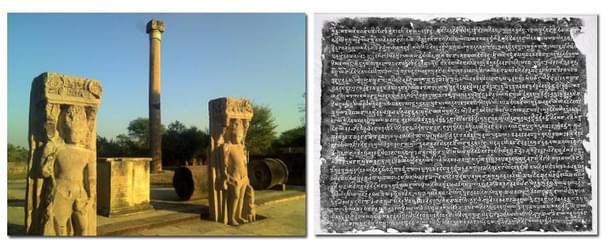
While it is true that Mihirakula was a worshiper of Rudra, that did not factor in Indic resistance to his invasion and atrocities. Far from that, the Indian ruler who proudly proclaimed the formation of a coalition of Indic principalities to fight Mihirakula (any resemblance to election-necessitated modern Shiva-devotee impostor is pure coincidence), was himself was a staunch devotee of Mahadeva – Yasodharma.
May the long flying banner of Shulapani (Trident wielding Shiva) destroy the strength of your enemies; the banner with the Nandi (Shiva’s bull), marked by the five fingers (dipped in Sandal and vermilion) of the daughter of the mountains (Parvati, the consort of Shiva), that bull whose bellowing causes all the quarters of the worlds shake and grips the demons with fear, whose horns shatter the rocks of the mountain Sumeru!
Eminent Indologist Hans Bakker finds in this inscription “the language of the war” and says “the Shaiva age had begun”, meaning the tone and worldview of the inscription show the heralding of the Shaiva age. But the enemy here was no heterodox religion, but the invader who also worshiped Shiva, but massacred Buddhists and civilians. The inscription says:
He whose head has never known humility save before Sthanu (Shiva), he whose expanding grabbing hands made the impregnable nature of Himalayas a false vanity, even that king Mihirakula, humbly offers worship at the feet of Yasodharma with the flowers fallen from his crest and with the arms of Yasodharma the head of the Huna king is bent painfully, compelled to pay obeisance.
Apart from Yasodharma, Baladitya or Narasimha Gupt, belonging to the Gupta dynasty, also offered resistance to Mihirakula. He not only defeated Mihirakula and rebuked him for the massacre of Buddhists, but eventually pardoned him and spared his life. This Gupta emperor, whose coins show him with Garuda standard and the Goddess Lakshmi on the reverse, also built a brick temple for the Buddha in the Nalanda University.
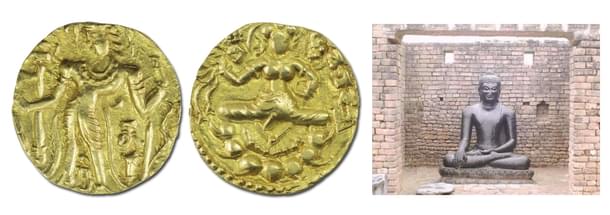
How has the traditional Hindu historiography viewed these events? The same grand narrative of traditional Hindu historiography that makes villains out of Ghazni and Ghori also makes a villain out of Mihirakula. The same tradition that makes Prithviraj Chauhan, Rana Pratap and Shivaji national heroes also makes Yasodharma and Baladitya or Narasimha Gupta – national heroes.
Incidentally, it is also not ethnic. Because Dara Shikoh, a Mughal prince, is to the collective memory of India, the representative of Indic spirit, a hero and a martyr for the essence of Indian culture, while his brother Aurangzeb shall always remain a villain.
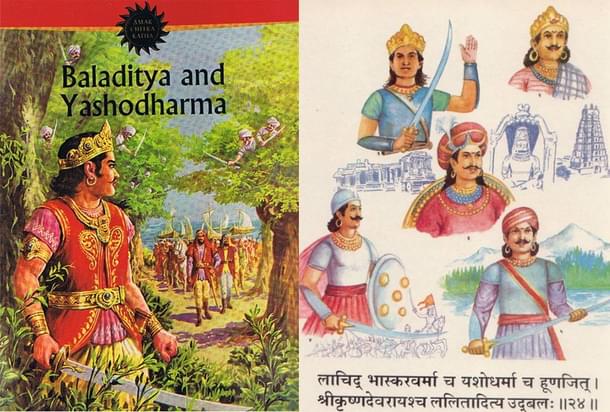
Even Nehru could not ignore the victory of Yasodharma over Mihirakula, though he reduced it to a few sentences. In his Discovery of India, he wrote:
These were the White Huns, as they are called, who ravaged the land, as under Attila they were ravaging Europe. Their barbarous behaviour and fiendish cruelty at last roused the people, and a united attack by a confederacy under Yashovarman was made on them. The Hun power was broken and their chief, Mihiragula, was made a prisoner. But the descendant of the Guptas, Baladitya, in accordance with his country’s customs, treated him with generosity and allowed him to leave India. Mihiragula responded to this treatment by returning later and making a treacherous attack on his benefactor.
However, subsequent history textbooks of free India rarely talked about this important Indic victory. Social science textbooks do not refer to him or say only a little about Yasodharma. After thus erasing the memory of Yasodharma through seven decades of institutional strangulation comes a Marxist historian, Jha, who inverses the narrative and wants the gullible, culturally illiterate English-reading Indians to believe that Mihirakula was a hero to ancient Hindus.
Brahminical Versus Heterodox
While there is no denying that there were and still are strong textual debates, dialogues, and even polemical attacks between sects, sometimes even violent conflicts, it was not a clear binary between Vedic-Brahminism and the so-called heterodox religions (by which he means Jainism and Buddhism). Far from being such opposing binaries, the Vedic, Buddhist, and Jain religious systems show organic inter-linkages, conflicts and harmonising relations between each other.
Indologist Yuvraj Kishan and Dr Kalpana K Tadikonda, an expert in Buddhist iconography, explain:
In fact, the Buddhist (and Jains) adopted the Vedic cultural features. In Vedic religion, the yajnasthana is treated as a caitya. It is significant that the Buddhist stupa is called asthi or dhatu chaitya, mound containing the sacred relic. ... In fact the account of the Buddha’s birth in the Buddhist text has considerable similarity with the story in the Rig Veda of the birth of Indra. (Dr P Banerjee, Birth of Buddha and its Vedic Parallel, Buddhist Iconography, p 1-6, 1984)The Buddha Image: Its Origin and Development, 1996, p 16
Adrian Snodgrass, an authority in Buddhist art and philosophy, agrees with this idea. He points out that there is “a continuity of symbolic content that runs from Vedic Brahmanism to Buddhism” and similar “considerable overlap of the symbolic expressions of later Hinduism and Buddhism”.
There is a common store of metaphysical symbols whence both traditions draw their spiritual sustenance. All that has been said of Brahman, Agni, Shiva and Vishnu as the skambha, the Cosmic Pillar, axis mundi and ontological foundation of the world, is equally true of the Buddha. ... Among the reliefs from Amaravati are to be seen many representations of the Buddha as a fiery pillar, comprising feet marked with the Wheel of the Dharma and a trident (trisul) head. The representation of the Buddha as a fiery pillar is a survival of the Vedic symbolism and more specifically that embodies in the God of Fire, Agni. The Buddha and Agni are ontologically equivalent persons.The Symbolism of the Stupa, 1992, p 170-1
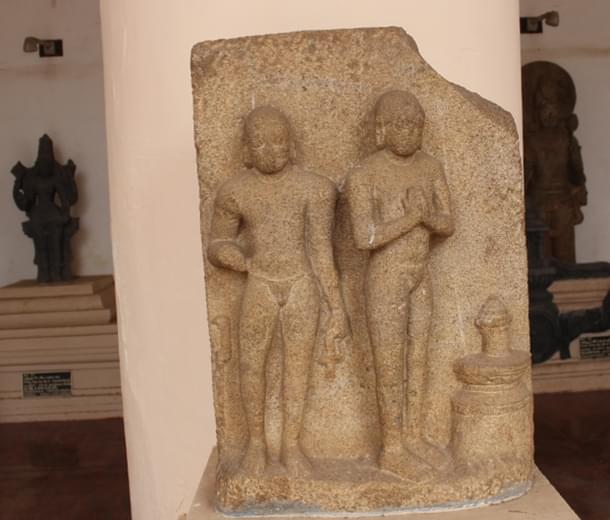
Even with respect to Vedic rituals, Buddha, as revealed in early Buddhist texts, had an approach that was consistent with the approach of pre-Buddhist Upanishads, which in turn had their roots in Vedas themselves. For example, Chandogya Upanishad, a pre-Buddhist upanishad, says that the real fire sacrifice – the highly exalted agnihotra – consists of oblations to the self. So the chest becomes the altar, the heart becomes the garhapatya fire, the mind, the anvaharya fire, and the mouth, the ahavaniya fire. If one does not understand this and does the ritual without intent, then it is depreciated by the upanishads as “an oblation offered in dead ashes after removing the live coals”.
Further, we also see here that the Vedic ritual is not only internalised, but transformed into an act of doing good to all beings – thus sharing of food, without the discrimination, also becomes a sacrifice.
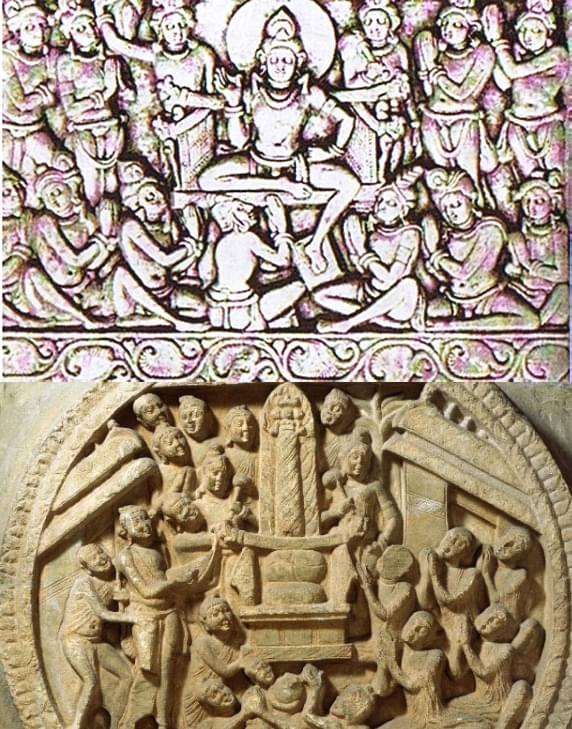
One finds the same methodology and symbolic interpretation of Vedic sacrifices in Buddha’s discourses too. In Kutadanta Sutta, the three modes of Vedic sacrifice correlate to the states of mind. The 16 conditions (requirements concerning the altar, the priest’s clothes, etc) are re-conceived as the cooperation of the four varnas and so on. In Aggi Sutta, while Buddha repudiates the fire ritual in which animals are offered, he proceeds to reinterpret them – ahavaniya corresponds to parents, garhapatya to wife, children, and servants, and the daksinagni to Brahmins and mendicants (Kiblinger, 2017).
Professor Kristin Beise Kiblinger in her book on Buddhist inclusivism, concludes that such Buddhist reinterpretations of Vedic sacrifices “are not subordinating sacrificial ritual under higher level Buddhist practices; rather they are replacing metaphysics with ethics”. But as seen earlier, this reinterpretation process has a continuity with the Upanishads. Mircea Eliade finds this type of reinterpretation, which he calls “ritual interiorization”, “pan-Indian” and traces it partly to Vedic hymns like the Rig Veda and Brahmanas. In Sutta Nipata, Buddha speaks of agnihotra as the best among the sacrifices and Savitri as the best among the hymns, and then he makes services rendered to the monks of the Sangha the best of the sacrifices.
While Buddhism shows an overall reverence to the Vedic sacred realm with suitable modifications of its own, there is also a bitter rivalry against Jainism revealed in Buddhist literature. Buddhist hagiography of Ashoka, Ashokavadhana, says that when a Buddhist devotee reported to Ashoka about a follower of Nirgrantha Jnatiputra, who drew a painting depicting the Buddha bowing down to Mahavira, Ashoka got enraged and ordered that “all of the Ajivikas in the whole of Pundavardhana be put to death at once”. According to the hagiography, on that day alone, “eighteen thousand of them were executed”.
Similarly, later in Pataliputra, when another devotee of Nirgrantha drew a painting of Buddha bowing to his master, Ashoka burnt the man and his entire family.
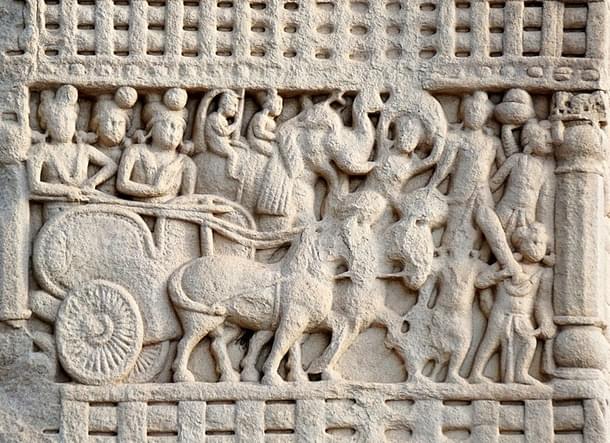
As we will see such accounts need to be studied more as exceptions to the general flow of Indian history, which is more about a conciliatory organic evolution that promotes religious diversity with mutual respect than allow destruction of any sect with expansionist monocultural tendencies. The point is that the binary of monolithic Vedic Brahminical bloc and non-Vedic heterodox bloc rests more on modern needs for an anti-Hindu political rhetoric than real historical facts. In fact, this politically convenient binary that Jha constructs by selective use of data, actually impedes the understanding of Indian culture and historical processes that shape Indian culture through unique values.
Samanvaya - The Process That Jha Intentionally Misses
Jha also speaks of the ‘retaliatory violence’ of the Vedic Hindus. In fact, there were conflicts between Buddhism and Jainism which were more severe than the one between so-called Vedic Brahminism and Buddhism. Questionable instances like that of Pushyamitra Sungha are brought in to emphasise the binary conflict.
But what about such violent conflicts recorded in ancient Indian history? Were they real persecutions? Do they in any way invalidate the picture of religious pluralism with mutual respect in ancient India, as alleged by Jha?
Even Dr Upinder Singh casts doubts on the nature of persecution of Buddhism under Pushyamitra. In her book on political violence in India, she points out that despite John Marshall linking 'great damage' that was 'wantonly inflicted' on Sanchi Stupa ‘with the anti-Buddhist reputation acquired by Pushyamitra Shunga’ and Pushyamitra ‘sometimes been held responsible for the destruction of the Ghoshitarama monastery at Kaushambi and the Deur Kothar stupa in central India’, ‘Sanchi and other Buddhist monasteries in central India continued to exist and flourish during the Shunga period.’ So she asks:
Was this in spite of Pushyamitra’s persecution of the Buddhists? Was it because later Shunga kings discontinued his anti-Buddhist policy? Or should the Buddhist stories of Pushyamitra’s persecution be considered exaggerated?
While conceding that it is ‘difficult to say for sure’, she thinks there might be ‘some historical basis’ while the claims of the Buddhist tradition ‘cannot be taken at face value.’ In the case of Sasanka, another king from East India, accused of persecuting Buddhists again the evidence, is wanting. As historian Sailendra Nath Sen points out 'the Chinese pilgrim's description of the flourishing condition of Buddhism, in Sasanka's capital cannot be reconciled with the active persecution of Buddhism' as alleged by the same Hsuan Tsang (Ancient Indian History and Civilization, p.276)
Textual accounts of violence – either to boast the victory or play martyrs – mostly do not portray the social reality – unlike in the case of Islamic conquest, where the textual boasting and ground reality get corroborated with evidence. An example is provided by historical facts discovered about Ashoka and the traditional account found in Ashokavadhana of him massacring Ajivikas. While the inscriptions found in the four caves on the Barabar Hill, north to Gaya, reveal that Ashoka donated these caves to the Ajivika ascetics.
Similarly, while Marxist historians like Jha and Romila Thapar insist on a confrontational model of conflict and replacement with the ‘Brahminical’ religions inflicting violence and persecution on the so-called heterodox religions, more and more detailed studies reveal that the movement of Indian culture was towards reconciliation and harmony. In fact, Tamil Nadu here provides a very good framework. The Shaivite account about voluntary impaling of 8,000 Jains, who were defeated by Thirugnana Sambandar, a seventh century Shaivite seer, had been often quoted by Marxist and colonial Indo-phobic scholars as an example of elimination and violent persecution of 'heterodox' sects by 'Brahminical' Hinduism.
Dr Lisa Owen, a specialist in Jain history studying the Jina images of Kalugumalai, Tamil Nadu, criticises what she calls the 'standard narrative’ which "presents the history of interaction in this region solely in terms of dispute and conflict between bounded and monolithic communities of Shaivas and Jains.” She supports the view of another Indologist, Richard Davis, specialising in Shaiva-Jain encounters who too points out that "if we cling to narratives such as the “standard narrative”, we lose sight of the complex ways in which these traditions interact and the ways these interactions are themselves constitutive”. Dr Owen also questions the categorisation of ancient Indian holy space in a linear manner as Vedic, Buddhist and Jain phases, which is part of the ‘standard narrative’ constructed by the dominant Marxist school historians:
The evidence of work being produced simultaneously at Ellora is, however, often not recognized by scholars as the site continues today to be described as exhibiting three separate phases: Buddhist, Hindu and Jain. This is unfortunate, as many of India’s ancient and medieval sites, particularly rock-cut monuments, clearly demonstrate multi-religious interests in their artistic expressions. This also seems to have been the case at Kalugumalai.Demarcating sacred space: the Jina images at Kalugumalai, International Journal of Jaina Studies, Vol 6 No 4 (2010)
What Owen and Davis point out in the context of Tamil Nadu is also true for entire cultural matrix of India, as has been pointed out by Susan Verma Mishra and Himanshu Prabha Ray in the context of Gujarat. Again, the distortion through selective concealment of facts, exhibited by Jha shows Hemachandra, the 12th century Jain scholar, as "denouncing the ancient code of law Manusmriti on the grounds that it supported ritual violence”. But what he does not reveal entirely about Hemachandra, is more relevant to the question in hand – the mutual respect and nurturing of pluralism – the defining nature of Indian culture and spirituality. Susan Mishra and Prabha Ray explain:
Hemachandra’s acceptance of (Shaivaite) Kumarapala’s creed was reciprocated by the sovereign, who was an important patron of Jaina foundations and reportedly worshipped at Jaina temples. This mutual participation in the practices of the other hints at meanings of religion and community identification that are not always acknowledged in modern academic framework.‘The Archaeology of Sacred Spaces: The temple in western India, 2nd century BCE–8th century CE’, Routledge, 2016, p. 159
So what we witness in Indian civilisation is that it never allows religious conflicts to become fully blown holy wars against any particular religious sect. The basic underlying dictum that has emerged from this understanding is enshrined in the Vedic statement Ekam sat viprah bahudha vadanti (Truth is one: Wise declare It with different names) RV 1.164.46 & AV 9.10.28)’. This in turn has set the process of Samanvaya, which is exemplified in the 12th century inscription of the Kesava temple at Belur, Mysore:
May Hari the Lord of the three worlds, worshipped by the Shaivas as Shiva, by the Vedantists as Brahman, venerated by the Buddhists as the Buddha, by the logicians as the chief causation, by the Jains as the emancipated being and by the ritualists as the principle of observance, grant our prayers.Cultural Study of Hoysala Inscriptions, Directorate of Archaeology and Museums in Karnataka, 2000, p.105
The complete annihilation of pagan religions one sees with the ascendancy of Christianity and Islam, is completely absent in Indian history. The reason is that despite the differing worldviews of the Vedic, Buddhist and Jain religions and among themselves the different sects, the Indian cultural genius understands the infinite possibilities of human psyche and its right to manifest and explore the potentials. Sectarian violence and doctrinal bigotry are tendencies that are witnessed throughout the world history. The uniqueness of Indian civilisational experience is the ability to rise above this with mutual respect for pluralism. It is this Indic genius, which manifests in the sacrifice of Guru Tegh Bahadur of Sikh Dharma, giving his very head to protect the Hindus of Kashmir from persecution.
The Explicit Prejudice Of D N Jha
As noted earlier, the reviewer uncritically and affirmatively comments that ‘it is no wonder, Alberuni (the 11th century Persian scholar who studied India) wrote, according to Jha that, Hindus are “haughty, foolishly vain and self-conceited”. They “believe that there is no religion like theirs”.
Again the actual quote in the context provides a very different meaning to this prejudiced comment by a chronicler, who accompanied an Islamist invasionist – Mahmud Ghazni. Al Beruni writes:
Mahmud utterly ruined the prosperity of the country and performed those wonderful exploits by which the Hindus became like the atoms of dust scattered in all directions and like a tale of old in the mouth of the people. Their scattered remains cherish, of course, the most inveterate aversion towards all Muslims.... Hindu sciences have retired far away from those parts of the country conquered by us, and have fled to places which our hand cannot yet reach, to Kashmir, Banaras and other places.
He then speaks of ‘peculiarities of the national character of Hindus’ – of course negatively and as ‘a folly’ and ‘an illness that has no cure’. But still he could see in Hindus a binding ‘national character’. And, it is here he says:
Hindus believe that there is no country but their, no nation like theirs, no kings like theirs, no religion like theirs, no science like theirs. They are haughty, foolishly vain, self-conceited and stolid.
Remember, that this is from a man who appreciates the massacring marauder of ‘infidel Hindus’, Mahmud Ghazni, as 'the lion of the world, the wonder of his time'. Though by most standards of Islamist chroniclers, Alberuni was tolerant of Hindus, he was also prejudiced against them. (We know that when Alberuni’s younger days idol, Arabian polymath scholar, Al Razi denounced the concept of prophecy, an older Alberuni joined hands with the orthodoxy and condemned Al Razi). And when a society was under a violent siege, what else could be expected of that society but aversion for the plundering, massacring invaders? Yet for Jha this statement becomes an objective description for Hindus after presenting a selective and distorted history of Hindus as one filled with sectarian violence.
The reason for such a hatred is not far to seek.
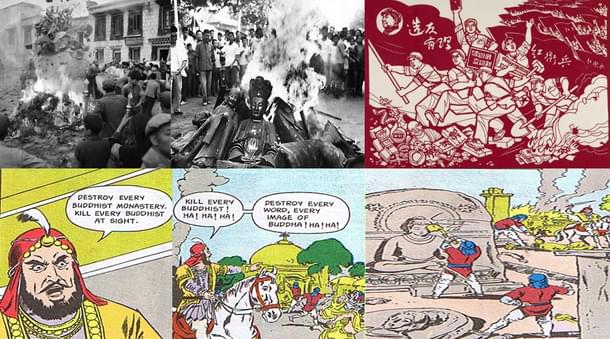
Jha himself aligns with a political ideology that executed the very recent cultural annihilation of Buddhism in China and genocidal violence in Tibet against Buddhism. Perhaps, he sees in Hindutva resistance to monocultural expansionist theologies and ideologies (like his own Marxism), the resistance of Yashodharma to Mihirakula?
Aravindan is a contributing editor at Swarajya.





